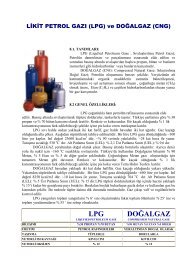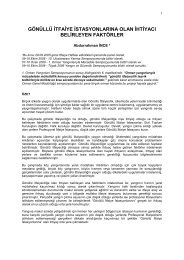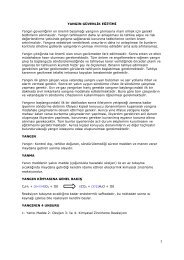buradan - Yangın
buradan - Yangın
buradan - Yangın
You also want an ePaper? Increase the reach of your titles
YUMPU automatically turns print PDFs into web optimized ePapers that Google loves.
from the growing fire moves the stratification level higher and<br />
higher. This is the reason that International standards will state the<br />
limitation on ceiling heights for certain types of fire detectors. This<br />
can be as low as 20 feet for point type heat detectors, 25 feet for<br />
point type smoke detectors, 30 feet for beam type smoke detectors,<br />
and flame detectors or a series of beam type detectors for anything<br />
above this height detectors in standard temperature rooms.<br />
Should the room temperature be lower than standard e.g. coldstorage<br />
facilities, the stratification height is significantly lower.<br />
3. Thermal Barriers.<br />
As previously stated, heat rises, therefore the hottest air will be<br />
found at the highest point in the room. This will create a barrier<br />
of hot air in which smoke will only penetrate if it is hotter. This is<br />
very evident in glass ceiling areas such as atria found in shopping<br />
malls.<br />
4. Diffusion.<br />
As smoke rises it will tend to drift sideways as well as upwards.<br />
Therefore the concentration of smoke will be lower as the smoke<br />
rises. It is the concentration of smoke that will eventually take a<br />
detector into alarm.<br />
5. Air Movement.<br />
Any air movement will take smoke away from the source of the<br />
fire. This is not a problem if you can predict the exact route of<br />
the air movement. In computer rooms, control rooms and clean<br />
rooms, this is usually known and therefore the detection can be<br />
placed across air conditioning vents etc. There will however be<br />
the need for additional ceiling detection for when the airflow has<br />
stopped (e.g. air conditioning switched off) and the smoke will take<br />
the traditional path of straight up.<br />
Should the protected areas be external (or an area with similar<br />
environment such as an aircraft hanger that has large doors<br />
open), then there would be no predictable airflow route, therefore<br />
impossible to detect efficiently with any other form of detection<br />
other than “at source” detection techniques.<br />
The solution to these problems is by “looking” at the risk; therefore<br />
detecting any impending fire “at source”, by doing exactly this, the<br />
VSD system does not encounter any of the above problems.<br />
Other “At Source” Detection Methods<br />
Other than VSD there are other “at source” type detectors. They<br />
are: -<br />
1. Thermal Imaging Cameras. These systems can detect changes<br />
in temperature by monitoring infrared emissions. They can be<br />
useful in a controlled environment where there are no other<br />
forms of unpredictable heat sources. They are impractical areas<br />
where heat sources such as cars, trains etc are moving through<br />
the “scene”. Line of sight must be achieved; and heat emissions<br />
may come after initial smoke emissions.<br />
2. Image Processing of Heat Changes. The way these systems<br />
work is by fitting a heat sensitive pad to known risk areas. These<br />
heat pads will change colour or contrast with the increase in<br />
temperature. This change can then be monitored and processed<br />
via the camera.<br />
3. The most popular fire detection systems by far in this category<br />
BİLDİRİLER KİTABI TÜYAK<br />
PROCEEDINGS BOOK 2009<br />
and have been previously employed for these types of detection<br />
scenarios were flame detectors. The problem is that by the<br />
time flames appear to trigger the device into alarm, serious<br />
damage has occurred and will rapidly increase; also significant<br />
amounts of smoke may have been emitted causing serious risk<br />
to personal health.<br />
How Does VSD Work<br />
VSD is based on sophisticated computer analysis of the video<br />
image seen by the CCTV camera (sensor). Using advanced imageprocessing<br />
technology and extensive detection (and known false<br />
alarm phenomena) algorithms, VSD can automatically identify<br />
the distinct characteristics of smoke and flame patterns. The fire<br />
detection industry has an abundance of known smoke and flame<br />
phenomena such as frequency of flicker etc, and all of these factors<br />
are built into the systems to give an accurate decision on whether<br />
smoke and/or flames are present.<br />
VSD systems use standard CCTV equipment (back & white, colour,<br />
infrared, existing or new) linked to a self contained processing<br />
system which is capable of recognising small amounts of smoke<br />
and flame patterns within the video image and alerting the system<br />
operator both at the processor and by a variety of remote outputs.<br />
VSD systems employ highly complex algorithms to process video<br />
information from up to eight cameras simultaneously. Under normal<br />
conditions with all eight cameras connected the system achieves a<br />
5Hz-frame rate for each channel.<br />
The video hardware is designed to allow simultaneous real time<br />
digitising of all eight images, which means that the system does not<br />
multiplex images and therefore no information is lost or delayed. All<br />
alarm condition images are log time & date stamped, and stored<br />
within the system’s memory.<br />
VSD systems detect smoke and flame rapidly by looking for<br />
small areas of change within the image at the digitisation stage<br />
and only passing these pixel changes to the main processor for<br />
further filtering. The video information is passed through a series of<br />
filters, which seek particular characteristics that can be associated<br />
with smoke and flame behaviour. Further analysis is then carried<br />
out on the relationships between the filtered characteristics to<br />
determine whether all the conditions have been met for the system<br />
to confidently predict the presence of smoke and/or flame.<br />
The system installer has the ability to vary the amount of smoke<br />
signal, and the length of time that the smoke exists before an<br />
alarm condition is raised to cater for situations where there may<br />
be background smoke present. The installer may also divide the<br />
video image into zones and programme the system to alarm only if<br />
smoke and/or flame is present in 2 or more zones.<br />
For even greater system performance 2 camera images can be<br />
associated together such that smoke and/or flame in one image<br />
is to be treated as a pre-alarm and smoke and/or flame in two<br />
associated camera images is treated as a full alarm.<br />
To provide compensation for areas of the image that could prove<br />
troublesome such as windows, mirrors or smoke producing<br />
processes, the installer or system user has the ability to eliminate<br />
TÜYAK 2009<br />
3





